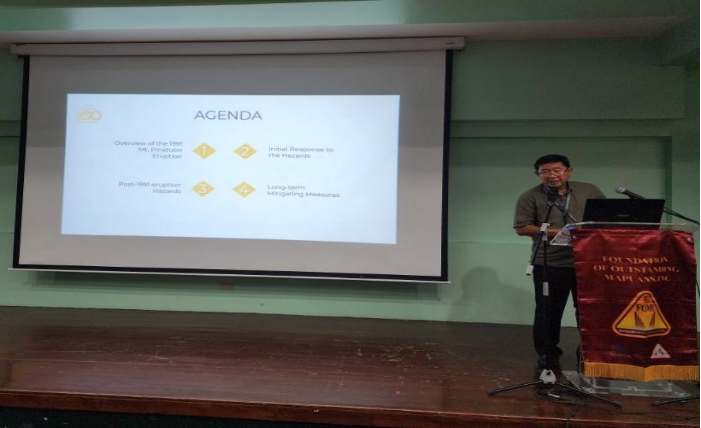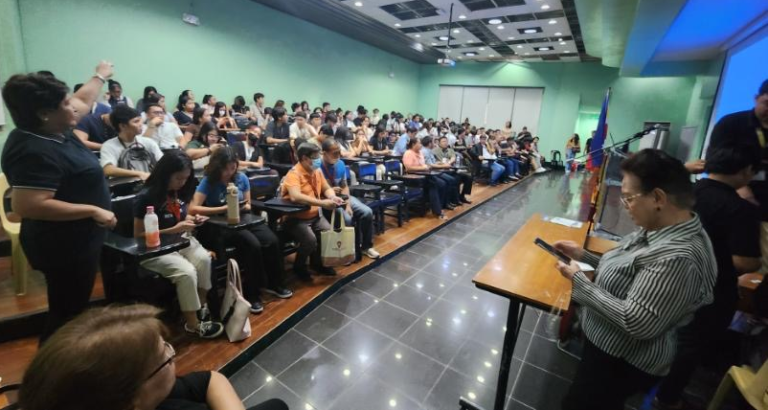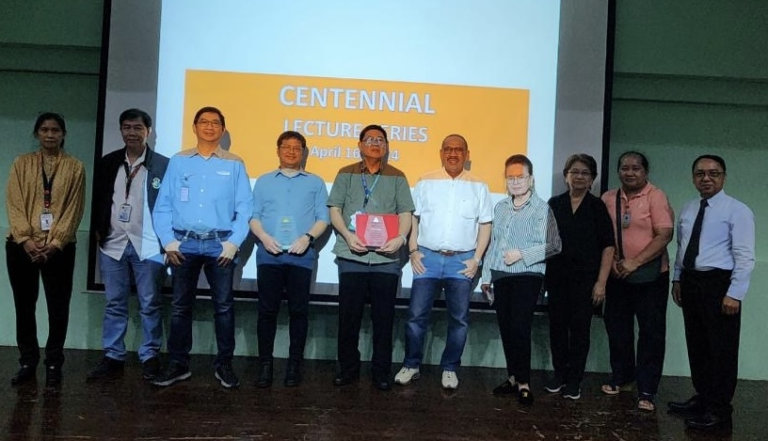News and Updates
Epsilon Mu Alpha Association Brods Speak at the 1st Centennial Lecture Series in Mapua
The 1st Centennial Lecture series commenced last April 16, 2024 at Mapua University. Our EMAA, Inc. Brods, Mr. Noel Lacadin and Dr. Arturo Daag are the first two speakers of the lecture series being conducted as part of the other activities for the 2025 Mapua Centennial celebration. This is through the initiative and program of the new FOMI president, Brod Engr. Sonny Sebial.
Dr. Gilford Estores, the Dean of School of Civil, Environmental and Geological Engineering, welcomed the participants and Engr. Sonny Sebial, President of the Foundation of Outstanding Mapuans (FOMI) also gave the opening message and introduced the speakers.




‘The 1991 Mt. Pinatubo Eruption’
Mr. Noel Lacadin, Officer-in-charge Regional Director and Concurrent Chief of the Geosciences Division, Region, MGB Regional Office III, lecture was entitled “The 1991 Pinatubo Eruption: Disasters of the Past, Opportunities for the Future”.
Brod Noel’s presentation was divided into four parts; 1) overview of the 1991 Mt. Pinatubo eruption; 2) initial response to hazards; 3) post-eruption hazards and; 4) long-term mitigating measures.
For part 1, Brod Noel presented an overview of the extent and distribution of eruption deposits, the observed volcanic pre-eruption activities and the damages caused by lahars in Angeles City, Bacolor, Pampanga and Barangay Lourdes, Bamban.
Part 2, initial response to hazards, summarized the works done and implemented after the 1991 eruption. These consisted of detailed preparation of volcanic hazard maps which were used as basis in the identification of permanent evacuation sites. Hazard assessment and warnings were also included in the public education. In addition, identification of hazard channels was similarly done. They were used as the basis for the appropriate engineering interventions designed to contain lahars and flood hazards.
Part 3, tackled the post-1991 volcanic eruption hazards and focused on the hazards from lahar generation and remobilization of pyroclastic deposits around the slopes of Mt .Pinatubo which can be caused or triggered by rainfall from seasonal monsoon and tropical typhoons. In addition, he also presented the documentation of infrastructure damages to dikes (e.g., Botolan, Bucao River, San Marcelino) caused by seepages, sand boil and collapse.
Part 4 of the presentation covered the long-term measures that were implemented such as: 1) engineering intervention (i.e., control structures, dikes); 2) removal of pyroclastic deposits through quarrying; 3) dredging of heavily silted portion of the river and; 4) implementation of coastal hazard assessment and hydrogeological monitoring(i.e., Bucao River, Sto. Tomas River and Botolan River and Maloma River).
In his concluding message, Brod Noel cited the hazard posed by the 1991 Mt. Pinatubo eruption particularly its environmental and social impacts. He stressed the importance of cooperation between the government and communities/stakeholders in order to minimize the possibility of repeating the dangers of the past.
‘Preparing for the Big One’
Dr. Arturo S. Daag, Associate Scientist of the Department of Science and Technology – Philippine Institute of Volcanology and Seismology (DOST-PHIVOLCS) shared his paper entitled “Preparing for the Big One in Greater Metro Manila. The focus of the talk is on the presence of an active fault in Metro Manila, that is, the Valley Fault System (VFS) which is around 100-km long transecting Bulacan, Quezon City, Pasig, Taguig, Laguna and Cavite. The VFS is capable of generating a magnitude 7.2 earthquake. Brod Doc Art, also discussed other surrounding active faults in the nearby province that could affect Metro Manila.
The scenarios for the magnitude event were discussed including impacts to human lives and properties, and the existing contingency plans (Oplan Yakal Plus). Likewise, tips on what to do BEFORE, DURING and AFTER an earthquake was also given as takeaway during the talk.
Based on the attendees, there were questions on what the government is doing to mitigate the impact of the earthquake. Per Brod Doc Art, the government has taken several measures, including various the Local Government Units (LGUs), that were directly transected by the VFS such as issuance of various ordinances prohibiting structures to be built on top of the active fault and consider in their planning the use of buffering zone along the fault as green zone like gardens, parks, and other non-residential facilities. He also discussed the use of web-based information such as the https://hazardhunter.georisk.gov.ph, which gives map-based information about the various geologic hazards in the Philippines.
Brod Doc. Daag concluded that we cannot predict the actual date or occurrence of the BIG ONE, and its prediction is only based on recurrence interval, that is, 400-600 years and the last known event was 1658. Since we know the impact, we should all be prepared, he added.
At the end of the lectures Engr. Carlito Alpay, Chairman of the FOMI developmental program, awarded the certificate of appreciation to all the speakers and gave the closing remarks.
The Epsilon Mu Alpha Association Inc., (EMAA, Inc.) thanks our Brods Noel Lacadin and Art Daag for their participation in the Centennial event. More power to you both.
